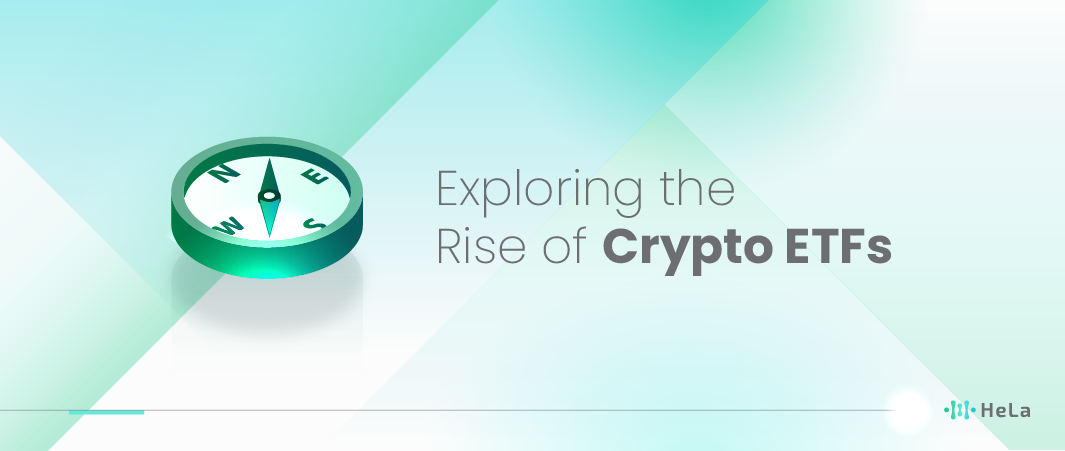The exchange-traded funds of cryptocurrencies (ETFs) has turned into a central innovation in the investment arena, and the ETFs give investors regulated and easily accessible tiers for them to earn participation in the fast-growing world of digital currencies Investors in this cryptocurrency market who are more diversified and without sacrificing convenience require means with which to gain exposure to the cryptocurrency asset class along the way as they also navigate its inherent complexities and risks.
As an answer to this demand, crypto ETFs have gained much popularity, making it easy for investors to have different crypto assets under one roof. Investments in such ETFs also enjoy diversification, liquidity, and regulatory oversight. Thus, this portion discusses how crypto-ETFs gradually mature, provide advantages to investors, have their drawbacks, and what their applicability is to the investment industry and investors who are in search of crypto-exposure to some extent on a regulated platform.
What is Crypto ETFs?

Crypto ETFs, which are exchange-traded funds on cryptocurrencies analogous to conventional ETFs but dealing with the dynamic crypto market, represent a new stream of investment. These fund vehicles present investors with the opportunity to take part in the digital asset space without the hassle of possessing the digital currencies directly.
One of the main perks of crypto ETFs is the possibility they offer to diversify without having to buy several brands because you buy all of them in one stock. This diversification assists in the distribution of risk amongst different assets, so that the effect of any cryptocurrency fluctuating on the overall performance of the fund is marginal. Yet, while the regulatory rules behind crypto ETFs fluctuate largely depending on the jurisdiction. Some are up, others are just getting on track, and the rest are currently holding back the pieces, not knowing what to do.
Structurally speaking, crypto ETFs can be either physically backed or futures based. In the case of physically backed ETFs, they actually hold the cryptocurrencies they are tracking, while the other kind of ETF utilizes futures contracts to mimic the underlying asset’s performance. Each holding type incorporates its own set of benefits and imminent dangers that are connected to price, liquidity, and tracking error rates.
The fact that crypto ETFs are accessible is one of the main characteristics they have. These capital pools allow traditional investors to get into crypto the way they are used to—through standard channels like brokerage accounts. This ease of use is very advantageous, especially for those investors who are apprehensive about dealing with the intricate processes of cryptocurrency exchanges while having to manage private keys and digital wallets. Through joining regulated trading platforms, crypto ETFs present liquidity and transparency in prices, increasing investor trust and assisting in the efficient discovery of the price.
But while investors have to pay attention to costs, ETF expenses are high. Management fees as well as other costs may be greater when compared to the ones of a traditional ETF, due to the complexities and volatility of a crypto market. In this regard, one of the substantial influences that crypto ETFs possess can be found in the cryptocurrency market as such. The additional participants for institutional and retail investors can result in higher consumer demand for digital currency, forcing the price up. On the one hand, the exponential increase in capital can give way to market manipulations and increased regulatory dynamics, but it can also bring in new guardians of the market.
Investments in crypto ETFs are great in their nature, but they still have some inherent risks. It involves the natural fluctuation of the cryptocurrency market, which is often unpredictable, the regulatory issues that have arisen in recent technologies, cyber threats, as well as the possibility of a failure in the underlying technology or compromising it. For that reason, investors should do their research correctly and understand the risks they will be confronting before they can invest in crypto ETFs, and they should be very careful so they can achieve their objective. Although crypto-ETFs offer you regulation and convenience as you invest in various cryptocurrencies, you’ll still need to exercise prudent risk management and conduct due diligence as the sector is evolving at a fast- pace.
Benefits of Crypto ETFs

Crypto ETFs, or cryptocurrency exchange-traded funds, offer several benefits to investors looking to gain exposure to the cryptocurrency market:
Diversification
Risk diversification is the investment doctrine that aims to spread the portfolio’s risk with the goal of mitigating the consequences of any assets performing poorly on the portfolio’s overall performance. Regarding crypto, ETF diversification can be treated as an extra tool because of the crypto market’s instability.
Some exchange-traded digital asset funds (also known as ‘ETNs’ ) offer investors a portfolio of several cryptocurrencies, so they will have the ability to understand the different assets of digital assets and that each of them has unique features of their networks and the dynamics of their own market. Diversification ensures to reduce the risk that any specific cryptocurrency gets adversely impacted or its values experience price fluctuations of huge magnitude. Moreover, the potential yields could be diversified, which would smooth out the volatility and stabilize the portfolio during the long- term risk adjustment.
Accessibility
Accessibility exhibits the extent of involvement that prospective investors can exert in a market or a certain asset. Crypto ETFs provide a user-friendly and familiar way that allows even non-traditional and inexperienced investors to earn exposure to the crypto space, since investors who do not have any previous experience or who feel unfamiliar with the digital exchanges may be so.
Investors who buy and sell ETF shares have the advantage since the same broker accounts they own can be used to buy shares, whereas there are many entry barriers associated with direct crypto ownership, such as creating digital wallets, managing private keys, and mastering the complexities related to cryptocurrency trading platforms. Furthermore, the availability of the cryptocurrency market creates a parallel universe wherein anyone, even without huge sums of money, can now expand their investment portfolio by tapping the growth potential of cryptocurrencies.
Also Read: Top 10 Metaverse Development Companies to Consider in 2024
Regulation and Security
Regulation and security are the most serious concerns for investors, particularly in the rapidly developing cryptocurrency market. Crypto ETFs are within the regulatory system of financial markets, which makes them safer to invest in and, at the same time, a great option for investors.
This framework sets up standards to manage the funds, disclose information, and be transparent with the investors. This reduces the risk of any fraudulent activities occurring and helps in the enhancement of investor confidence. In addition to that, investing in crypto ETFs might deliver enhanced security compared with the direct ownership of cryptocurrency tokens since these investors do not have to worry about the security risks of storing digital assets in wallets or trading on unreliable exchanges.
Liquidity and Price Transparency
Liquidity expresses the possibility of the asset being bought or sold in a short time without strongly impacting the asset’s price. Crypto ETFs generally trade on regulated exchanges, which allow investors to make both purchases and sales at any moving price during the whole trading day.
This liquidity becomes imperative to investors who want to go into or out of positions at the right time and in a manner that is efficient, provided the market is, like cryptocurrencies, volatile. Consequently, trading on regulated exchanges enables investors to partake in price transparency, where they can see the real-time market prices and work on the trades at fair and competitive rates. This transparency ensures that the shareholders receive information that is true and timely, and hence they can make the investment decisions they feel are right and proper.
Lower Entry Barrier
Cryptocurrency ETFs are characterized by a lower entry barrier, which may attract larger crowds of investors, which already shows that the cryptocurrency market is considered a good investment option. Unlike direct cryptocurrency ownership, which can demand technical knowledge and training, buying shares in crypto ETFs is like any other stock purchase performed through a brokerage account.
The standardized and recognizable characteristics of crypto ETFs encourage traditional investors who would have avoided cryptocurrencies due to the perceived complexities or risk factors to embrace and engage them. With their entrance into the field, crypto ETFs will possibly attract a larger investor base, which will undoubtedly lead to an increase in demand and liquidity.
ETFs Challenges and Considerations

Investing in Exchange-Traded Funds (ETFs) comes with several challenges and considerations that investors should be aware of:
Market Volatility
ETFs are just like any other investment with their inherent price volatility.
Diversification is one thing that ETFs offer by having a bunch of securities in their basket. However, a change in market conditions or underlying securities might still cause price fluctuations for the ETFs as well. Investors need to understand the facts that short-term price fluctuation may occur, requiring the attention of time, discipline, and calm.
Tracking Error
ETFs here attempt to mirror the performance of a respective index or asset class to which they are supposed. Regardless, certain aspects, including the costs to trade, the fees, and the portfolio rebalancing, can trigger the actual situation, which is the tracking error—a divergence between the performance of the ETF and that of the benchmark.
Tracking errors are typically insignificant, but they can accumulate in the long run and poorly affect the ETF’s underlying index. Investors are advised to attentively review a fund’s record of tracking errors and possibly think about other factors that may contribute to them when selecting ETFs.
Liquidity Risks
Liquidity (the ease of buying or selling an asset without a disturbance to its price) is the asset’s most valuable quality. It is worth noting that most of the ETFs trade on primary exchanges with high-liquidity ratios, while others, particularly those that track niche markets and have lower trading volumes, are unable to meet the liquidity needs.
The very low liquidity, on the other hand, may lead to the growth of bid-ask spreads and trading costs’, making the process of trade execution much harder with prices set at the level of your choosing. Investors should evaluate the liquidity of the ETF they are investing in and take note of its trading volume and market depth before putting in their money. They are at risk of trading frequently or purchasing a large volume of the stocks.
Costs and Expenses
ETFs incur fees and costs connected to the management of the fund, which includes: management fees, operating costs, and trading expenses.
Although ETFs are famously known for their low expense ratios compared to actively managed mutual funds, these costs can still whittle away earnings eventually, especially for long-term investors. The total cost of ownership is an essential consideration in selecting ETFs for investors to take into account. Explicit and implicit costs are some of the factors to be weighed up, such as expense ratios, brokerage commissions, and bid-ask spreads.
Complexity of Asset Allocation
ETFs allow you to diversify across a variety of asset classes, sectors, and investment strategies, thus providing a highly flexible tool for diversification. However, the enormous options and the construction of complicated asset allocation can be a confusing matter for individuals who do not have enough experience or knowledge of the financial markets.
The creation of a diversified and well-balanced portfolio that incorporates ETFs is a critical process that involves a deep knowledge of the investors’ risk tolerance, objectives, and horizons and a stringent research and due diligence process. Investors can consider some options in which they can consult professional financial advisors or use online asset allocation tools and resources to help them with investment decision-making.
The Future of Crypto ETFs

The prospects of crypto ETFs in the future are bright, with the cryptocurrency market developing by the day and a maturity level attained. undefined
Regulatory Developments
Regulatory certainty is an important aspect of crypto ETFs as they spread globally. As the global regulatory body establishes strict rules and design protocols for cryptocurrency-based ventures such as ETFs, it is expected that investors will gain more confidence in the market and more products will flood the market.
Regulators’ supervision can help to resolve investor protection and market manipulation risks, as well as the systemic consequences. This way, retail participation could be expanded in the cryptocurrency market by means of ETFs.
Also Read: 10 Best Crypto Exchanges and Apps to Know in 2024
Expansion of Offerings
With increasing demand for crypto ETFs, more possibilities emerge for product portfolio customization to satisfy the requirements of different ETF investors and risk levels.
These may be in the form of ETFs that are based on a particular type of cryptocurrency, the sectors within the cryptocurrency market, or even innovative investment themes. Then, innovation in ETF structures, for example, actively managed ETFs or smart beta strategies, can also be helpful in expanding the array of investment choices for investors.
Integration with Traditional Finance
The incorporation of cryptocurrency ETFs will keep growing with the intersection of the traditional financial industry and investment products.
With institutional investment in cryptocurrencies increasing, there is a chance of demand for investment vehicles such as ETFs that offer digital asset exposure within applicable and regulated regimes. Integration with traditional finance acts as a bridge between the existing traditional market system, increases its liquidity, and creates a more efficient market.
Technological Advancements
Cutting-edge technologies, especially blockchain technologies and digital asset infrastructure structures, may fuel the need to be innovative in the development and features of crypto ETFs.
Smart contract based platforms and decentralized finance protocols are the ones that could realistically usher in the transition from old fashioned to more sophisticated ETF models like tokenized or programmable ETFs, which automatically rebalance and have governance as well. Taking into account the fact that a variety of protective measures and regulatory compliance technology would facilitate this process, these new features will undoubtedly have an impact on crypto ETF operations.
Global Adoption
Going along with that, the globe is sure to witness greater interest in crypto ETFs as more regulatory authorities look into the advantages associated with secure and regulated cryptocoin investment products.
For example, there is already some support for crypto ETFs in a number of countries, but other countries are still working towards developing appropriate regulatory frameworks or assessing the associated risks and benefits. Globally, the support of institutions and their traders could lead to more liquid markets, lowering regulatory arbitrage, and raising the level of investor participation in the cryptocurrency market.
Conclusion
Cryptocurrency ETFs are a great step ahead in the investment field as they present a regulated and easier to use way for investors to acquire the cryptocurrency market. These investment alternatives allow diversification, accessibility, and possible tax benefits, all of which make them attractive for both retail and wholesale investors.
Nevertheless, crypto ETF investments have some disadvantages that must be taken into account. Investors need to take into consideration aspects like market volatility, tracking errors, liquidity risks, costs and taxes, regulatory risks, and structural changes before investing. Moreover, the regulator’s developments, tech improvements, and market dynamics will be the unique factors shaping the nature of crypto ETFs in the future.
Disclaimer: The information provided by HeLa Labs in this article is intended for general informational purposes and does not reflect the company’s opinion. It is not intended as investment advice or a recommendation. Readers are strongly advised to conduct their own thorough research and consult with a qualified financial advisor before making any financial decisions.

